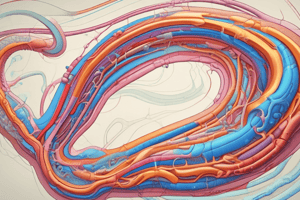Podcast
Questions and Answers
What is the main function of the thick ascending limb in the countercurrent mechanism?
What is the main function of the thick ascending limb in the countercurrent mechanism?
- Actively transports sodium ions outward (correct)
- Creates a high lumen-negative potential difference
- Allows water reabsorption back into the interstitium
- Has high water permeability
Why does the thin segment of the Loop of Henle maintain low water permeability?
Why does the thin segment of the Loop of Henle maintain low water permeability?
- To prevent water entry back into the interstitium (correct)
- Due to the presence of aquaporins
- Having more transport proteins compared to other segments
- To facilitate passive diffusion of chloride ions
What contributes to the creation of a steep osmotic gradient in the medullary interstitium?
What contributes to the creation of a steep osmotic gradient in the medullary interstitium?
- Absence of aquaporins in the thick ascending limb (correct)
- Active transport of sodium ions in the descending limb
- Passive diffusion of potassium ions in the thin segment
- Presence of aquaporins in the thick ascending limb
How does the descending limb contribute to the initial urine concentration?
How does the descending limb contribute to the initial urine concentration?
Which activity in the countercurrent mechanism leads to a continuous influx of water into the surrounding interstitium?
Which activity in the countercurrent mechanism leads to a continuous influx of water into the surrounding interstitium?
What is the primary role of the countercurrent mechanism in nephron physiology?
What is the primary role of the countercurrent mechanism in nephron physiology?
Which part of the nephron contains the structure responsible for the countercurrent mechanism?
Which part of the nephron contains the structure responsible for the countercurrent mechanism?
What is the significance of the countercurrent multiplier system in nephron physiology?
What is the significance of the countercurrent multiplier system in nephron physiology?
How does the countercurrent mechanism in the Loop of Henle contribute to maintaining fluid balance?
How does the countercurrent mechanism in the Loop of Henle contribute to maintaining fluid balance?
What is unique about the arrangement of the thin segment of the Loop of Henle in terms of the countercurrent mechanism?
What is unique about the arrangement of the thin segment of the Loop of Henle in terms of the countercurrent mechanism?
Flashcards are hidden until you start studying
Study Notes
Understanding Nephron Physiology: Exploring the Countercurrent Mechanism
The kidneys' primary role is filtering waste products from your bloodstream while maintaining essential nutrients and electrolytes like sodium and potassium within optimal levels. A critical component of this filtration system lies within each kidney—the nephrons. To grasp how these microscopic functional units manage fluid balance, let's delve into their structure and explore one of their most intriguing features, the countercurrent mechanism.
Structure of a Nephron
A typical nephron consists of two sections: the renal corpuscle, containing the glomerulus surrounded by Bowman's capsule; and the tubular section, composed of three main parts—proximal convoluted tubule, loop of Henle, and distal convoluted tubule—which eventually merge with collecting ducts.
How Filtrate Moves through Nephrons
In its journey, filtered fluid passes over thin descending limbs and thick ascending limbs within the Loop of Henle, where water movement through osmosis relies heavily upon the countercurrent mechanism. This unique arrangement allows the kidneys to regulate body fluid composition effectively.
The Countercurrent Multiplier System
The Loop of Henle can be divided into three segments: descending limb, thin segment, and ascending limb, each contributing to the countercurrent multiplier system. As the name suggests, this setup enhances concentration gradients across loops rather than simply moving fluids along them. Here's why:
- Descending Limb: In the descending limb, water moves freely via osmosis from the surrounding interstitial fluid due to a high lumen-negative potential difference. This creates an initial urine concentrate that serves as the starting point for further solute accumulation and dilution in subsequent limbs.
- Thin Segment: Adjacent to the descending limb, the thin segment has fewer transport proteins and less permeable membranes compared to other portions. Consequently, it maintains a low water permeability, preventing the entry of water back into the interstitium. Therefore, the remaining concentrated liquid continues towards the thicker ascending limb.
- Ascending Limb: The thick ascending limb, enriched with Na+/K+-ATPase pumps, actively transports sodium ions outward against their electrical gradient and potassium ions toward the interior. Alongside the passive diffusion of chloride ions following sodium, these activities result in a continuous influx of water into the surrounding interstitium. However, since the thick ascending limb also lacks aquaporins, water remains trapped outside, becoming part of the hypertonic medullary interstitium and creating a steep osmotic gradient required for efficient concentrating ability.
This delicate dance between segments ultimately results in a highly concentrated urine exiting the distal portion of the Loop of Henle, enabling efficient regulation of body water and electrolyte balance.
Considering the complexity and significance of the countercurrent mechanism, we acknowledge its integral function in nephron physiology. By grasping this fundamental understanding, you will gain valuable insights into the sophisticated processes governing kidney function.
Studying That Suits You
Use AI to generate personalized quizzes and flashcards to suit your learning preferences.




